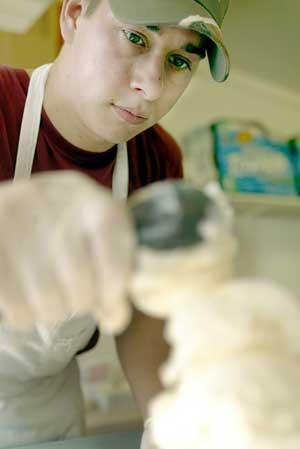
From the small corner of a buiding at the State Fair, Alexis Corbilt, a graduate student in nutrition, takes an order from a fairgoer for one cup of ice cream.
“One Chocolate” Corbilt said to the group of Food Science Club members inside the building.
“Got it,” Drew Watson, a senior in food science, said as he reaches for a white styrofoam cup.
Watson leans over an open refrigeration unit filled with nine different kinds of ice cream, including chocolate, vanilla, butter pecan and cherry vanilla, and begins to scoop away at the frozen brown cream with a metal spoon. He then places three scoops of the frozen concoction in the bowl and walks to the window, handing over the cold chocolate ice cream and a plastic spoon.
The ice cream’s long journey through the University system ends as it is consumed amongst fairgoers holding cooked turkey legs, baked corn and fried candy bars. It serves as one of the few cold treats on a day when the temperature is 10 degrees above average.
Its journey started at the Dairy Education Unit where University cows are milked. The cows are milked in groups of six, two groups at a time, twice a day. They get used to the routine according to Jason Overcash, a recent graduate in agriculture business and current lifelong student.
“Most cows walk right in here. They know what it’s like,” Overcash said. “It takes a lot of pressure off them. Their bags get tight. Think of carrying 60 pounds of milk around. Thats a lot of weight.”
Once the cows are done, the milk is stored and then shipped.
“It’s shipped to the creamery straight from the farm,” Laurie Steed, a graduate student in food science and Food Science Club co-chair, said, “Thats where they pasteurize it.”
According to Gary Cartwright, plant manager for the creamery, from there the milk is separated into whole milk, skim milk and cream before it’s pasteurized and stored overnight. The raw ingredients for ice cream are added before pasteurization.
The next morning flavors are put into the mix.
“Everything starts off as vanilla,” said Steed, “We have high-tech equipment to make the other flavors.”
The ice cream is frozen and ingredients like cookies, pecans or cherries are added. It’s then packaged and stored at temperatures near minus 18 degrees Fahrenheit.
The Food Science Club then buys the ice cream from the creamery and sells it at the fair. All profits go to the group for scholarships, travel costs and food-science conventions.
Last year the group raised about $50,000 from the 10-day sale, according to Watson.
Davis Lenzi, a junior in zoology, said she made a point to stop at the Dairy Bar with her friend Sara Younger, a freshman at UNC.
“We walked straight here,” Lenzi said, “we love this ice cream.”